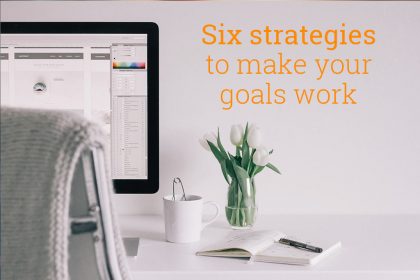Six steps to creating a powerful vision board
Want to channel your energy more productively as you work towards your professional or personal goals? Follow those six steps and create a powerful vision board.
Vision boards are a powerful tool to keep your creative energy focused on what’s most important to you – your vision for the future.
They’re not a road-map or plan to follow, but a visual reminder each day of what we you working towards, and why we you doing it. By visualising your dreams every day, it helps to change how you perceive your actions and how they relate to achieving your dreams.
Six steps to creating a powerful vision board
To help you create a powerful vision board that will keep your energies directed positively here are six easy steps to follow.
1) Devote some time to it
Your board isn’t a project you can fit in during a break in work, or something to distract you while commuting. It’s something worth investing proper, single-minded time in.
You will need at least an hour to get started, if not more. Remember this is about visualising your future, so you want to think carefully about it!
Make sure that the time you set aside is free of distractions and other obligations, too. Don’t try and do it if you have kids clamouring for your attention or when your office is a mess.
2) Define your dreams
A vision board isn’t just a collection of pictures of things you like – it is a tool with a purpose. So begin by defining your vision.
What exactly is it that you are hoping to achieve with the board? You could say “I want to be debt free in three years” or “I want to have my office organised and paperless by the end of the summer.”
It doesn’t matter what your goal is. Just ensure it’s tangible and that you can measure and track your progress. (Read more about setting a SMART goal here.)
3) Brainstorm
Next decide what you need to do to achieve your goal. Think of words, affirmations, inspiring quotes, role models, images, or small items that relate to, or remind you of, your goal.
It could be a photo of a clean desk, or the work “calm.” It could be a phrase, “less is more”, or a stunning image of a pristine forest if your goal is to reduce paper for environmental reasons. There are no set rules for what you put on your vision board, as long as you can identify it with your vision.
4) Collect your visions
Once you know what you want your vision board to say, you can begin looking for things to put on it. You will of course, need a board. I can be a piece of cardboard, a framed cork-board, or a white-board that you can doodle on when it strikes you. (Or you may decide to set your vision board up on Pinterest.)
Then collect the objects you intend to put on it. It can be anything from pictures, small items and mementos, to encouraging notes and letters, swatches of colour and stickers.
Remember, there are no rules for what can go on it. If it fits your board and serves a purpose for helping you see your vision, it goes on!
5) Arrange them carefully
Spend some time placing the items in a way that is visually appealing to you, and will help you see the connections between the objects and your dreams.
Avoid making it too cluttered, and use colours and backgrounds that inspire the feelings you are working towards. Blues are good for calm and order, reds and oranges for energy and motivation.
6) Display it where you will see it
Don’t tuck your vision board out of the way and out of sight. Instead, place it where you will see it frequently, and spend some time looking at it and reflecting on it each day.
Let it bring you back to your defined goal, and evaluate whether you have made steps toward achieving your dream that day.
Kate Thora is a Senior Content Specialist for Uphours.com, an online resource with information about businesses worldwide. When not working, she likes to catch up with the latest business trends on her favourite industry blogs.










